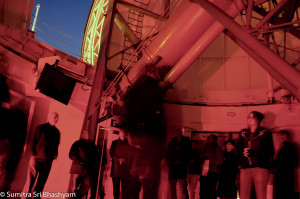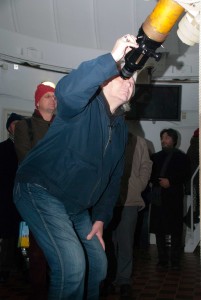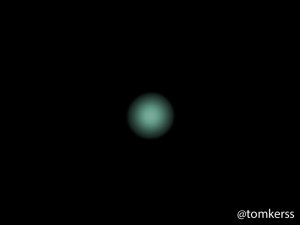November 19, 2013
Viewing with the 28-inch Telescope – 19th November 2013
Report by: Nick Phillips
As the new organiser for our members-only event I was a little nervous of the weather not being kind to me, especially with the last couple of weeks of wind, rain and the astronomers nemesis; cloud, but as the day went on, my spirits were lifted by the clearing skies and the fair reports.
As the members arrived it looked as though the night was going to be clear and cold and that our chances of seeing our targets for the evening were going to be good. We met in the Astronomy Centre cafe for a warming cup of tea, before heading up to the 28-inch telescope dome.
In the dome we met with our Astronomer for the evening, Tony Sizer, who had already been in the dome for a while with another ROG astronomer, Tom Kerss. They had been attempting some imaging of the planet Uranus. Tom has also kindly allowed us to post his image of Uranus.
Our first target for the evening was Uranus, an ice giant and the seventh planet from the sun. Uranus was discovered by William Herschel in 1781. Its atmosphere, mainly made up of Hydrogen, Helium and Methane, appeared as a blue / green sphere in the eyepiece of the the 28-inch. The image, made a little fuzzy by our very active atmosphere on the evening, was difficult to see, but the appearance of a solid globe shape gave it the definition for us to know it was a planet. Looking through the eyepiece you could also see some other very small pin-points of light and there was much discussion between the members as to whether they could actually see some of the moons. However, unfortunately, I think they were background stars!
We then moved onto our second target of the evening, Gamma Andromedae, also know traditionally as Almach. It is the third brightest point of light in the constellation of Andromeda. A double star with two distinct colours is a real treat to look at through the 28-inch as it was actually designed to look at double stars and Almach didn’t disappoint in this task. Through the eyepiece you could see the brighter golden star (Gamma 1 Andromedae) next to a dimmer, indigo blue star (Gamma 2 Andromedae) clear and crisp, this was a beautiful image to look at.
Finally, we just had enough time to get a fix on the Moon, having not long risen. We had to have the telescope almost as far over to the east as possible and, nearly full, the moon was very bright. We fitted a polarising filter to the 6-inch finder scope to take some of the intensity out of the brightness that gave us a darker image of the whole moon which people really enjoyed. As for the 28-inch, we focused in on the Mare Crisium (Sea of Crises), one of the lunar seas created by Volcanic activity around 3.5 billion years ago. A dark Basalt rock, Mare Crisium can just about be seen with the naked eye but through the 28-inch you could immerse yourself in the lunar world.
Alas, the evening had to come to an end and it was starting to feel very cold on the fingers and toes, so as Tony and I brought the telescope back to its parked position and closed the dome, our guests made there way out of the observatory.
Tom Kerss recorded a short time-lapse in the 28-inch telescope dome, just before the evening’s entertainment got on its way. This video can be seen via this link, or via the link below:
Images from the Event (by Christina Chester, Sumitra Sri Bhashyam and Tom Kerss):
Posted under: 28-Inch Equatorial Viewing, Flamsteed, Meeting Report









You must be logged in to post a comment.